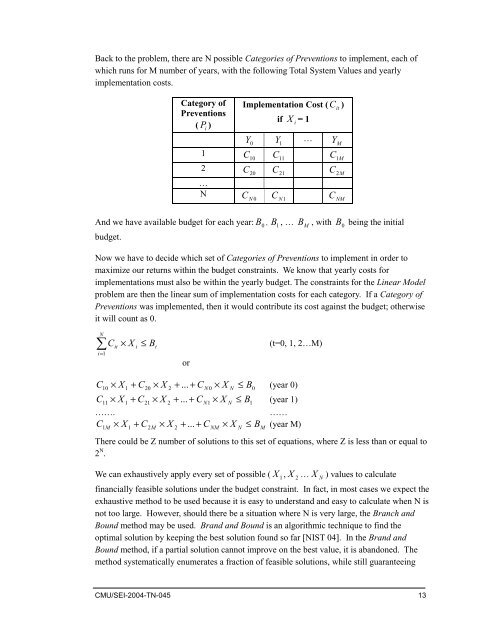SQUARE Project: Cost/Benefit Analysis Framework for Information ...
SQUARE Project: Cost/Benefit Analysis Framework for Information ...
SQUARE Project: Cost/Benefit Analysis Framework for Information ...
You also want an ePaper? Increase the reach of your titles
YUMPU automatically turns print PDFs into web optimized ePapers that Google loves.
Back to the problem, there are N possible Categories of Preventions to implement, each of<br />
which runs <strong>for</strong> M number of years, with the following Total System Values and yearly<br />
implementation costs.<br />
Category of<br />
Preventions<br />
( P<br />
i<br />
)<br />
1<br />
2<br />
…<br />
N<br />
Implementation <strong>Cost</strong> ( C<br />
it<br />
)<br />
if X<br />
i<br />
= 1<br />
Y<br />
0<br />
Y<br />
1<br />
C<br />
C<br />
10 11<br />
C<br />
20 21<br />
…<br />
Y<br />
M<br />
C 1 M<br />
C C 2 M<br />
C<br />
N 0<br />
C<br />
N1<br />
C<br />
NM<br />
And we have available budget <strong>for</strong> each year: B<br />
0 , B<br />
1<br />
, …<br />
budget.<br />
B<br />
M<br />
, with B<br />
0<br />
being the initial<br />
Now we have to decide which set of Categories of Preventions to implement in order to<br />
maximize our returns within the budget constraints. We know that yearly costs <strong>for</strong><br />
implementations must also be within the yearly budget. The constraints <strong>for</strong> the Linear Model<br />
problem are then the linear sum of implementation costs <strong>for</strong> each category. If a Category of<br />
Preventions was implemented, then it would contribute its cost against the budget; otherwise<br />
it will count as 0.<br />
N<br />
∑<br />
i=1<br />
C<br />
it<br />
× X<br />
i<br />
≤ B<br />
t<br />
or<br />
(t=0, 1, 2…M)<br />
C<br />
10<br />
X<br />
1<br />
+ C20<br />
× X<br />
2<br />
+ ... + C<br />
N 0<br />
× X<br />
N<br />
≤ B0<br />
11<br />
X<br />
1<br />
+ C21<br />
× X<br />
2<br />
+ ... + CN1<br />
× X<br />
N<br />
≤ B1<br />
× (year 0)<br />
C × (year 1)<br />
…….<br />
……<br />
C1 × X<br />
1<br />
+ C2<br />
× X<br />
2<br />
+ ... + C × X ≤ B (year M)<br />
M<br />
M<br />
NM<br />
N<br />
There could be Z number of solutions to this set of equations, where Z is less than or equal to<br />
2 N .<br />
We can exhaustively apply every set of possible ( X<br />
1, X<br />
2<br />
…<br />
M<br />
X N<br />
) values to calculate<br />
financially feasible solutions under the budget constraint. In fact, in most cases we expect the<br />
exhaustive method to be used because it is easy to understand and easy to calculate when N is<br />
not too large. However, should there be a situation where N is very large, the Branch and<br />
Bound method may be used. Brand and Bound is an algorithmic technique to find the<br />
optimal solution by keeping the best solution found so far [NIST 04]. In the Brand and<br />
Bound method, if a partial solution cannot improve on the best value, it is abandoned. The<br />
method systematically enumerates a fraction of feasible solutions, while still guaranteeing<br />
CMU/SEI-2004-TN-045 13
















